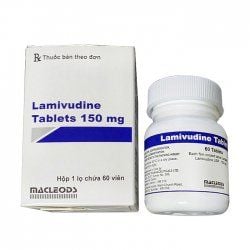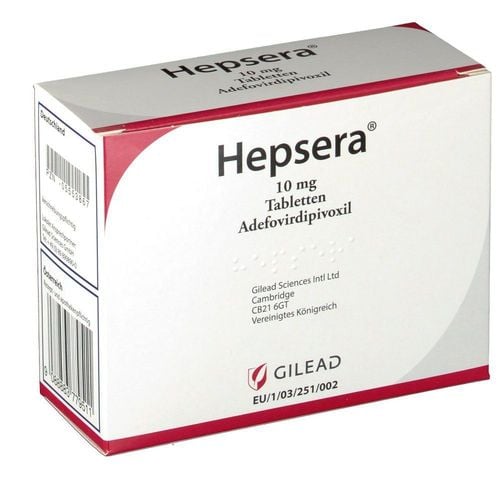This is an automatically translated article.
Efatrio belongs to the group of parasitic, anti-infective, antiviral, and antifungal drugs used to treat HIV-1 infection in adults and adolescents. Let's learn about drug information Efatrio through the article below.1. What is Efatrio?
Efatrio drug is prepared in the form of film-coated tablets, with the main ingredients being Efavirenz 600mg, Lamivudine 300mg, Tenofovir disoproxil fumarate 300mg.
Efavirenz has anti-HIV-1 activity by specifically inhibiting non-nucleoside reverse transcriptase, thereby inhibiting viral over-synthesis and growth.
After entering the body, Lamivudine is converted to the active substance Lamivudin-5'-triphosphate, which competes with deoxycytidine triphosphate, inhibits reverse transcriptase, thus inhibiting viral DNA synthesis.
After entering the small intestine, Tenofovir disoproxil fumarate will be converted to Tenofovir, then phosphorylated to the active form Tenofovir Diphosphate, thereby inhibiting HIV-1 reverse transcriptase and hepatitis B virus polymerase enzyme .
Combining these 3 active ingredients together will help increase the effectiveness of anti-HIV virus, thus increasing the effectiveness of treatment.
2. What does Efatrio do?
Efatrio is used in both adults and adolescents (age 12 years and weighing 40 kg) in the treatment of HIV-1 infection where viral suppression reaches HIV-1 RNA densities < 50 copies/ml when have been on combination antiretroviral therapy for more than 3 months. The patient has not experienced treatment failure in any prior antiretroviral therapy. The use of Efatrio to treat HIV-1-infected persons already receiving antiretroviral therapy should be based on an individual patient's resistance test or previous treatment history.
Do not use Efatrio in the following cases:
People who are sensitive to lamivudine, tenofovir, efavirenz or any of its ingredients. People with severe liver and kidney disease.
3. Dosage of Efatrio
Dosage depends on each case:
Adults and adolescents (from 12 years old and weighing ≥ 40kg): take 1 tablet/time/day. Not recommended for use in children under 12 years of age. Do not use in patients with renal impairment with creatinine clearance < 50 ml/min. The pharmacokinetics of the drug has not been established in subjects with hepatic impairment. Patients should be closely monitored for adverse events, especially neurological symptoms associated with efavirenz. How to take the drug: Take the tablet whole with water on an empty stomach, should be taken before bed to reduce unwanted effects on the central nervous system.
4. Side effects of the drug Efatrio
When using Efatrio, you may experience some of the following undesirable effects:
Increase in fasting triglyceride levels, total cholesterol, HDL, LDL, increase liver enzymes, decrease blood phosphate. Dizziness, headache, insomnia, somnolence, abnormal dreams, hair loss. Itching, skin rash Abdominal pain, nausea, vomiting, flatulence, diarrhea. Muscle pain, joint pain Fever, cough, nasal symptoms, fatigue Anxiety, depression, concentration disorder When using Efatrio, if the patient experiences any serious side effects, stop taking the medicine. and contact the treating doctor or go to a medical facility for timely handling.
5. Interactions with Efatrio
When using Efatrio in combination, there may be interactions with some of the following drugs:
Interactions related to Lamivudine: Sulfamethoxazole and Trimethoprim can increase the concentration under the Lamivudine curve by 40%. Interactions related to Tenofovir: When used concurrently with Aminoglycoside drugs, Vancomycin, Tacrolimus, amphotericin B,... increases the risk of nephrotoxicity. Efavirenz-related interactions
6. Notes and cautions when using Efatrio
When using Efatrio, it is necessary to pay attention to the following issues:
Use with caution in the elderly, people with a history of convulsions or mental disorders. The drug should be discontinued when symptoms of hepatotoxicity or liver enzyme levels increase 10 times the upper limit of normal, severe rash or erythema of the skin, including Stevens-Johnson syndrome. When clinical symptoms or other laboratory findings suggest pancreatitis. During treatment with efavirenz it is necessary to monitor lipid and blood glucose levels. The use of antiretroviral drugs may cause proliferation of adipose tissue due to redistribution or accumulation of body fat, including anterior-posterior neck hypertrophy ("buffalo hump"), abdominal obesity, nerve damage. peripheral mammary gland enlargement, Cushing's syndrome. Immune-activated syndrome: People with HIV who are severely immunocompromised at the start of combination antiretroviral therapy (CART) may develop asymptomatic inflammatory reactions or infection. opportunistically, worsening symptoms or causing serious clinical conditions. Close bone monitoring is recommended in HIV-infected individuals with a history of pathological fractures or at risk for osteoporosis. After discontinuation of tenofovir in patients with co-infected HBV and HIV, close monitoring of liver function is recommended for an additional several months. Patients taking Efatrio or any antiretroviral therapy may develop opportunistic infections or other complications from HIV infection. Treatment with Efatrio does not eliminate the risk of HIV transmission, so appropriate HIV transmission precautions should be maintained. The drug should not be used in the first 3 months of pregnancy, in the second 3 months of pregnancy only use when carefully weighing the benefits and risks. If you are infected with HIV, you should not breastfeed under any circumstances to avoid the risk of transmitting the disease. Use caution when using the drug in people who do potentially dangerous jobs such as driving or operating machinery. In addition to the above information, if you have any questions about Efatrio, you can contact your doctor for advice and answers.













